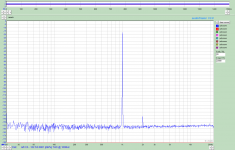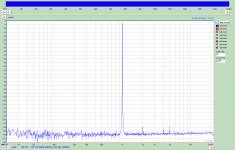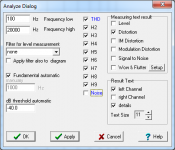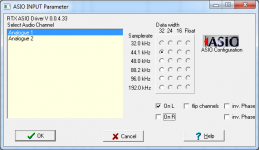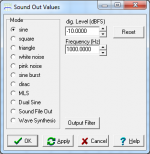The input impedance is high enough that very little current will be circulating so very little magnetic field to couple. The beer can should be fine. However aluminium is a real PITA to solder to. If something from this list would work it would be great: RF Shields | DigiKey
Happened to have mu metal to hand but your logic is, of course, sound and a simple aluminium lager can screen appears to do an excellent job of completely killing the (capacitive) crosstalk and is easy to make.
Note that I am NOT here recommending such a 'fix' as I don't know what the implications are for warranty etc and out of courtesy any such recommendations should come from the designer who will understand any nuances of the design that we are not privy to.
I do note that on max sensitivity (and all connectors open circuit) the unit is slightly microphonic, shows up as a transient around 500Hz on the spectrum. its an observation NOT a criticism for such a sensitive piece of kit, just wondering if anyone else is seeing this? Note that I have the screen fitted so maybe its a function of that. Unlikely (will remove it in due course and check) but thought I would note that in case its a side effect.
Seem to have got as much as I can from the stand alone performance now cross talk appears sorted so will now move onto loop back tests ASAP.
Happened to have mu metal to hand but your logic is, of course, sound and a simple aluminium lager can screen appears to do an excellent job of completely killing the (capacitive) crosstalk and is easy to make.<snip>
PS by microphonic I mean the perturbation is there when the unit or the desk it is on is tapped, its not there all the time.
loop back THD results
Initial loop back tests (attached hopefully, still learning how to use this site) are coming up with results similar to post #565. I'm not currently finding any combination of loop back settings that gives more than about -114 dB for THD as measured using AudioTester V3
In 'DIY Audio Analyzer with AK5397/AK5394A and AK4490' post #714 Jens tested some early samples using loop back in Jan and getting a THD of between -127 and -133 dB so on the face of it it seems I'm at least 13dB short of that.
Unfortunately I don't have a separate ultra low THD source so I can't easily disaggregate the distortion of the signal generator DtoA 'output' from the AtoD 'input' section so not easy for me to analyse this matter further.
Could of course be finger trouble on my part. Any thoughts welcome.
Initial loop back tests (attached hopefully, still learning how to use this site) are coming up with results similar to post #565. I'm not currently finding any combination of loop back settings that gives more than about -114 dB for THD as measured using AudioTester V3
In 'DIY Audio Analyzer with AK5397/AK5394A and AK4490' post #714 Jens tested some early samples using loop back in Jan and getting a THD of between -127 and -133 dB so on the face of it it seems I'm at least 13dB short of that.
Unfortunately I don't have a separate ultra low THD source so I can't easily disaggregate the distortion of the signal generator DtoA 'output' from the AtoD 'input' section so not easy for me to analyse this matter further.
Could of course be finger trouble on my part. Any thoughts welcome.
As nyt writes, you get the best THD performance at around -15 dBFS.
You should be able to get around -124 dB THD at 48 kHz sample rate with -20 dBFS, output attenuator set to maximum and input set to 10 dBV.
The values below -130 from the early models were achieved with a different configuration of the DAC. Part of the very low numbers were probably due to distortion cancellation.
One drawback of the configuration used at the time was that it worked very well at e.g. -18 dBFS, but the distortion increased rapidly when approaching full scale. With the new configuration I do not see the very low distortion values, but the advantage is that the distortion increases much less when approaching full scale, giving a more consistent performance.
You should be able to get around -124 dB THD at 48 kHz sample rate with -20 dBFS, output attenuator set to maximum and input set to 10 dBV.
The values below -130 from the early models were achieved with a different configuration of the DAC. Part of the very low numbers were probably due to distortion cancellation.
One drawback of the configuration used at the time was that it worked very well at e.g. -18 dBFS, but the distortion increased rapidly when approaching full scale. With the new configuration I do not see the very low distortion values, but the advantage is that the distortion increases much less when approaching full scale, giving a more consistent performance.
Unfortunately we are behind schedule on the invoicing and shipping.
We have to date shipped 47 units. So there is still some way to go.
At the moment I am not quite sure if we will be able to send additional units this week. Next week the office is closed, so unfortunately the remaining units will be postponed to January.
I apologize for the delays and hope that it won't cause too much problems for you all.
Jens
We have to date shipped 47 units. So there is still some way to go.
At the moment I am not quite sure if we will be able to send additional units this week. Next week the office is closed, so unfortunately the remaining units will be postponed to January.
I apologize for the delays and hope that it won't cause too much problems for you all.
Jens
As nyt writes, you get the best THD performance at around -15 dBFS.
You should be able to get around -124 dB THD at 48 kHz sample rate with -20 dBFS, output attenuator set to maximum and input set to 10 dBV.
The values below -130 from the early models were achieved with a different configuration of the DAC. Part of the very low numbers were probably due to distortion cancellation.
One drawback of the configuration used at the time was that it worked very well at e.g. -18 dBFS, but the distortion increased rapidly when approaching full scale. With the new configuration I do not see the very low distortion values, but the advantage is that the distortion increases much less when approaching full scale, giving a more consistent performance.
Jens, thanks and I do agree that the performance now achieved is consistent and certainly VERY impressive overall.
Still struggling to get a reported THD (AudioTester V3) better than about -112 to -114dB for any sensible combination of inputs and outputs though. Will keep trying and once I have my thoughts together (code for checking I'm not saying anything stupid) I will send a few pics.
Has anyone else done THD tests (ideally with AudioTester) that they can comment on?
Unfortunately we are behind schedule on the invoicing and shipping.
We have to date shipped 47 units. So there is still some way to go.
At the moment I am not quite sure if we will be able to send additional units this week. Next week the office is closed, so unfortunately the remaining units will be postponed to January.
I apologize for the delays and hope that it won't cause too much problems for you all.
Jens
It's all good Jens...perfect actually...until January it is.
Still struggling to get a reported THD (AudioTester V3) better than about -112 to -114dB for any sensible combination of inputs and outputs though.
I made a quick test with AudioTester V3, RTX at my default 0dB/0dB setting, got -122dB THD @-15dBFS.
At 20dBV/10dBV setting, reached -130dB THD (output @-10dBFS).
Attachments
Last edited:
Hi Gluca,
I think someone is trying to organise a group buy to see if they can get a discount. Keep your eyes on these threads to find out.
Even at their list price, from what I have seen of this unit you can't beat that price. The construction is excellent (looked at the shield mounting clips). Saving up for one of these is definitely worth while if you need a tool like this. The alternative is an Audio Precision, and that costs 4 ~ 5 times the list price here.
-Chris
I think someone is trying to organise a group buy to see if they can get a discount. Keep your eyes on these threads to find out.
Even at their list price, from what I have seen of this unit you can't beat that price. The construction is excellent (looked at the shield mounting clips). Saving up for one of these is definitely worth while if you need a tool like this. The alternative is an Audio Precision, and that costs 4 ~ 5 times the list price here.
-Chris
I made a quick test with AudioTester V3, RTX at my default 0dB/0dB setting, got -122dB THD @-15dBFS.
At 20dBV/10dBV setting, reached -130dB THD (output @-10dBFS).
Can you post the settings clearly including Audio Tester Analyze menu values/Input setting/output setting on the audio
I have been struggling with some of the setups myself. I found each one of the setup values affect the Distortion S/N ratio values. Confusing for some one new to the FFT software.
Hi Gluca,
I think someone is trying to organise a group buy to see if they can get a discount. Keep your eyes on these threads to find out.
Even at their list price, from what I have seen of this unit you can't beat that price. The construction is excellent (looked at the shield mounting clips). Saving up for one of these is definitely worth while if you need a tool like this. The alternative is an Audio Precision, and that costs 4 ~ 5 times the list price here.
-Chris
I hope. Actually I just noticed the GB too late even thou I've been lurking the main development discussion since the beginning ... I got distracted for a few months
I have to admit that THD+N measurements from Audio Tester is very tricky, and I never manage to get it working consistently (not just with RTX, but with my other sound cards also), which is why I prefer ARTA or REW, even though I have paid a license for Audio Tester.Can you post the settings clearly including Audio Tester Analyze menu values/Input setting/output setting on the audio
I have been struggling with some of the setups myself. I found each one of the setup values affect the Distortion S/N ratio values. Confusing for some one new to the FFT software.
The THD measurement from Audio Tester is consistent with other software though. Attached are the settings I used for the measurement at post #613.
Attachments
- Status
- Not open for further replies.
- Home
- Group Buys
- GB for RTX6001 Audio Analyzer with AK5394A and AK4490
